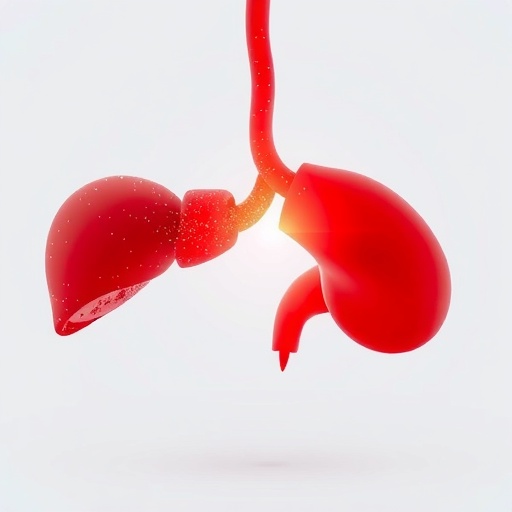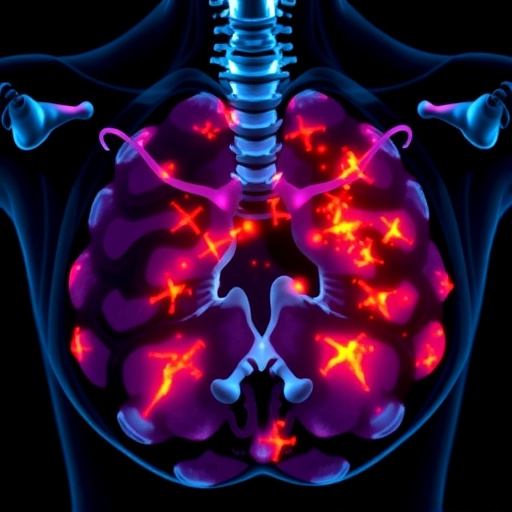Acute myeloid leukemia (AML), a formidable hematologic malignancy characterized by the uncontrolled proliferation of abnormal myeloid progenitors, has long posed a significant challenge to clinicians and researchers alike. Despite advances in understanding its pathophysiology, AML remains marked by low remission rates and a high propensity for relapse, underscoring an urgent need for novel diagnostic and therapeutic targets. In a groundbreaking study published in BMC Cancer, a team of investigators has unveiled the role of DExH-Box Helicase 9 (DHX9) as a critical player in AML pathogenesis and prognosis, potentially setting the stage for new clinical paradigms.
DHX9, a member of the DExD/H-box family of helicases, functions fundamentally in RNA metabolism, DNA replication, and genomic stability. Previously noted for its elevated expression in various solid tumors where it correlated with adverse outcomes, DHX9’s contribution to hematologic malignancies had remained elusive. The current research bridges this gap by elucidating its overexpression in AML cases and highlighting its prognostic significance and functional impact on leukemic cell biology.
To accurately quantify DHX9 levels in AML, the researchers developed a highly sensitive and specific absolute quantitative PCR assay. This innovative approach utilized tailored gene primers and TaqMan probes to deliver precise measurement of DHX9 transcript abundance in patient samples. The validated detection method not only enabled the differentiation of AML patients from healthy controls but also served as a robust tool for downstream prognostic evaluations.
Employing Receiver Operating Characteristic (ROC) curve analyses, the study demonstrated that elevated DHX9 expression strongly associates with both diagnostic discrimination and poor clinical outcomes. Notably, AML patients stratified into high-risk categories exhibited significantly increased DHX9 levels, implicating this helicase as a biomarker for aggressive disease phenotypes. This correlation underscores the potential utility of DHX9 quantification in guiding risk-adapted therapeutic strategies.
Delving deeper into DHX9’s biological role, the research team employed shRNA-mediated gene silencing to explore its functions in cultured AML cell lines, specifically THP-1 and MOLM-13 cells. DHX9 knockdown precipitated marked reductions in cellular proliferation and alterations in cell cycle progression, suggesting that DHX9 supports leukemic cell growth through regulatory control over these processes. This finding highlights the helicase as a facilitator of AML blast expansion.
In addition to inhibiting proliferative capacity, DHX9 depletion induced apoptosis and triggered differentiation in AML cell models. The induction of programmed cell death and the promotion of maturation pathways signal that DHX9 may function to maintain leukemic cells in a proliferative, undifferentiated state. Therapeutically targeting DHX9 could revert these malignant cells to a more differentiated and less aggressive phenotype, offering a novel avenue for AML treatment.
The functional analyses were complemented by comprehensive bioinformatic investigations, which revealed a significant association between DHX9 expression and metabolic pathways critical to AML cell survival and proliferation. This suggests a previously unappreciated role for DHX9 in the metabolic reprogramming characteristic of AML blasts — potentially providing new insights into how metabolic dependencies could be exploited therapeutically.
Metabolic reprogramming in cancer, including heightened glycolysis and alterations in mitochondrial function, represents a hallmark of malignancy that supports unchecked growth and resistance to therapy. The DHX9-metabolism nexus discovered in this study points to DHX9 as an essential integrator of metabolic signals, possibly orchestrating the crosstalk between genetic control machinery and metabolic networks to sustain leukemic cell fitness.
Taken together, these data support a model wherein DHX9 acts as an oncogenic driver in AML. By fostering leukemic proliferation, impeding differentiation, and modulating metabolic circuits, DHX9 contributes to disease progression and treatment resistance. This multi-faceted role justifies deeper exploration into DHX9 inhibitors, which could disrupt these oncogenic activities and improve patient outcomes.
Furthermore, the identification of DHX9 as a prognostic marker opens the door for its incorporation into clinical practice. Its expression profile could refine risk stratification algorithms, allowing clinicians to identify patients at heightened risk of relapse or aggressive disease who may benefit from intensified therapeutic regimens or novel clinical trials targeting DHX9.
The study’s innovative methodological approach, combining molecular assays, functional genomics, and bioinformatic pathway analysis, exemplifies the power of integrated research in unraveling complex cancer biology. Such multidisciplinary efforts are vital for translating genomic discoveries into practical solutions for patient care.
In addition to advancing our understanding of AML biology, the findings contribute broadly to the field of RNA helicases in cancer. DHX9 represents a compelling example of how these enzymes, traditionally viewed through the lens of nucleic acid metabolism, can influence diverse cellular processes integral to oncogenesis.
The implications of this research extend beyond AML, prompting inquiry into DHX9’s roles in other hematologic malignancies and solid tumors where metabolic rewiring and impaired differentiation are also central features. Such investigations may expand the therapeutic relevance of DHX9-targeted strategies.
Looking forward, clinical validation studies assessing the prognostic performance of DHX9 in larger, independent AML cohorts are warranted. Additionally, preclinical studies developing and testing DHX9 inhibitors or gene-editing approaches could lay the groundwork for future clinical trials.
In summary, this pioneering work identifies DHX9 as a novel prognostic biomarker and a functional contributor to AML pathogenesis. By illuminating its influence on proliferation, apoptosis, differentiation, and metabolism in AML blasts, the study sets the stage for novel diagnostic and therapeutic opportunities, heralding a potential shift in the management of this challenging malignancy.
Subject of Research: Acute myeloid leukemia (AML) and the role of DHX9 helicase in disease prognosis and cellular function.
Article Title: DHX9 as a prognostic biomarker and its biological roles in acute myeloid leukemia
Article References:
Xiong, Y., Chen, Y., Luo, H. et al. DHX9 as a prognostic biomarker and its biological roles in acute myeloid leukemia. BMC Cancer 25, 1464 (2025). https://doi.org/10.1186/s12885-025-14708-6
Image Credits: Scienmag.com
DOI: https://doi.org/10.1186/s12885-025-14708-6




